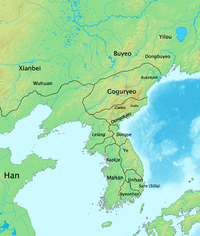Okjeo
| Okjeo | |
| Hangul | 옥저 |
|---|---|
| Hanja | 沃沮 |
| Revised Romanization | Okjeo |
| McCune–Reischauer | Okchŏ |
| History of Korea |
|---|
 |
| Timeline |
|
|
Okjeo was a Korean tribal state which arose in the northern Korean peninsula from perhaps the 2nd century BC to the 5th century AD.
Dong-okjeo (Eastern Okjeo) occupied roughly the area of the Hamgyŏng provinces of North Korea, and Buk-okjeo (Northern Okjeo) occupied the Duman River region.
Dong-okjeo was often simply called Okjeo, while Buk-okjeo was also sometimes referred to as Chiguru (置溝婁, 치구루) or Guru (구루)[citation needed], the latter name being also applied to Goguryeo. Okjeo bordered the other minor state of Dongye on the south, and shared a similar fate.
History

In its early history, Okjeo oscillated between domination by the Chinese commanderies and by Goguryeo.[1] From the 3rd century BC to 108 BC, it was controlled by Gojoseon. Due to the constant interference of its neighbors, Okjeo never grew into a fully centralized kingdom.
In 28 BC, King Dongmyeong sent Bu Wiyeom to attack the Northern Okjeo. In the 1st or 2nd century AD, King Taejo of Goguryeo reduced Okjeo to a tributary, which delivered local products to Goguryeo. During the 244 Wei Invasion of Goguryeo, Goguryeo’s King Dongcheon briefly retreated to North Okjeo, and in 285, the Buyeo court also temporarily escaped to Okjeo under northern nomadic attacks.
In early 5th century, Okjeo was completely conquered by Gwanggaeto the Great of Goguryeo.
Culture
Our knowledge of Okjeo culture is fragmentary. As with the Dongye and Okjeo's language, food, clothing, architecture, and customs were similar to that of Goguryeo. The Okjeo people practiced arranged marriage by which the child-bride lived with the child-groom's family until adulthood, and they interred the dead of a family in a single coffin.
See also
Notes
- ^ Byeon 1999, p. 49.
References
- Byeon Tae-seop (변태섭) (1999). 韓國史通論 (Hanguksa tongnon) (Outline of Korean history), 4th ed. ISBN 89-445-9101-6.
- Lee, K. (1984). A new history of Korea. Tr. by E.W. Wagner & E.J. Schulz, based on the 1979 Korean ed. Seoul: Iljogak. ISBN 89-337-0204-0
